wen0092/iStock/GettyImages
Light batter or breading is an ideal way to conceal shrimp’s shellfish taste for the diner who doesn’t enjoy seafood that tastes “too fishy.” But even avowed seafood fans enjoy the simple, savory delight of fried shrimp. Your choice of batter or dry flour affects the ways you prepare and fry the shrimp. To ensure the best possible results, coat the shrimp properly and fry them at the optimal temperature.
Preparing the Shrimp
Remove the heads and shells from the shrimp, but leave the tails intact; they make it easier to handle the shrimp when you cook and eat them. Deveining the shrimp -- removing the black “vein,” which is actually the shrimp’s intestine -- is not required. But some diners think the vein gives the shrimp a gritty texture and unpleasant taste. To devein the shrimp, run the tip of a paring knife down the back to expose the vein. Slide the tip of the knife under the vein, then lift the knife to pull the vein out of the shrimp. Rinse the shrimp in cool water, then pat them dry.
Choose the Right Crust Ingredients
All-purpose flour is perfectly suitable for shrimp batter or breading, but you may want to use another starch to enhance the texture or appearance of the shrimp. Self-rising flour, which is all-purpose flour that also includes baking powder and salt, yields a lighter, puffier crust. Achieve the same result by adding baking powder to unleavened flours and starches. Rice flour absorbs less oil than wheat flours, yielding a crisper crust. Potato starch browns the most effectively, which gives the crust a richer golden color. Blend these starches with all-purpose flour or use them alone. Season the batter or flour to taste with dry herbs and spices.
Build the Best Batter
Batter creates a more uniform crust on the shrimp than dry coatings. Add a moist ingredient, such as hot sauce or beer, to batter in place of milk or water. Fry shrimp immediately after dipping them in the batter. Cooks almost always deep-fry battered shrimp, but you can shallow-fry them as well as long as the oil in the pan is at least 1/4 inch deep.
Keep It Dry
A dry flour coating is not as uniform as batter, but it yields a slightly crisper crust that has more texture. Dip shrimp in an egg wash, milk or buttermilk before dredging them in dry flour. A light coat of liquid enables the flour to stick to the shrimp more effectively. Place the coated shrimp on a baking sheet to air-dry for up to 30 minutes so the crust binds to the shrimp. You can deep-fry, shallow fry, pan fry and oven fry breaded shrimp in deep, shallow or no oil.
Pans and Depths
Use a deep pan with a heavy bottom to prevent spilling and minimize splattering. When deep frying, the oil should be deep enough to completely submerge the shrimp. When shallow frying, the oil should be about 1/4 to 1/2 inch deep. There should be at least 2 inches between the top of the oil and the rim of the pan to prevent excessive splattering. To pan fry the shrimp, you only need a little oil -- 1 tablespoon or enough to cover the bottom of the pan, or you can skip the oil, if desired. To oven fry the shrimp, brush the baking pan lightly with oil, mist it with cooking spray or forgo the oil altogether.
Cooking Oils, Temperatures and Times
The ideal temperature range for frying food is from 350 to 375 degrees Fahrenheit. Your frying oil should have a smoke point above that temperature range. Corn and olive oils have a smoke point of 410 F; canola oil has a smoke point of 435 F; peanut oil has a smoke point of 450 F. Monitor the temperature of the oil with a deep-fat frying thermometer or candy thermometer. Only place shrimp in oil that is between 350 F and 375 F. If it's not hot enough, the crust absorbs too much oil and becomes soggy. If the oil is too hot, the crust burns before the shrimp cooks through. f you are oven frying, set the oven for 400 F since some of the heat is lost between the heat source and the food. Shrimp are done when the crust is golden and the flesh is white and opaque throughout. It should take shrimp approximately 4 to 6 minutes to fry, regardless of the coating you use.
Related Articles

Can I Bake Frozen Breaded Shrimp Rather ...

Can I Use Flour to Make Breaded Shrimp?

How to Straighten Shrimp for Tempura

How to Fry Shrimp With Potato Starch

Can You Deep-Fry Frozen Uncooked Shrimp?
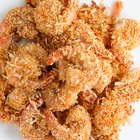
How to Make Coconut Shrimp
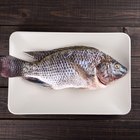
How to Deep-Fry Tilapia

Jumbo Shrimp Nutritional Facts
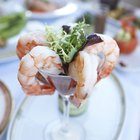
How Long Can Shrimp Be Refrigerated?
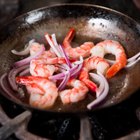
How to Cook Shrimp in a Skillet
Do I Steam or Boil Shrimp?

What Can I Substitute for Cake Flour to ...

Can You Cook Fried Okra With Flour?
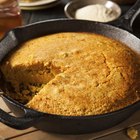
How to Make Southern Fried Cornbread

Frying Whiting Fish Using No Flour

How to Fry Mullet
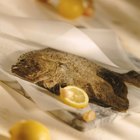
How to Roast Whole Flounder
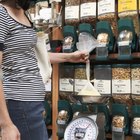
The Best Ways to Fry Hush Puppies
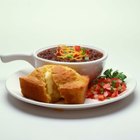
How to Make Cornbread in a Cast-Iron ...

What Kind of Oil Do I Use to Cook a ...
References
Writer Bio
Lamar Grey has been writing about cooking and food culture since 2010. He has ghostwritten eight cookbooks. Grey entered the culinary industry in 2003 as a prep cook in a full-service restaurant. He subsequently served as a baker and head cook on three award-winning kitchen staffs.